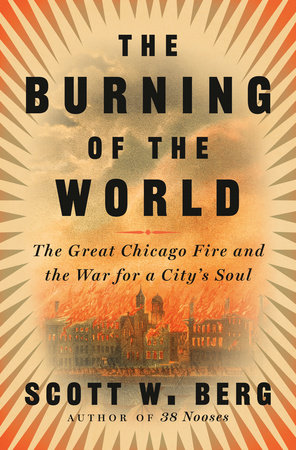The Burning of the World: The Great Chicago Fire and the War for a City’s Soul
- By Scott W. Berg
- Pantheon
- 464 pp.
- Reviewed by Dean Jobb
- October 5, 2023
A propulsive account of the 19th-century Midwestern inferno.

Like most human-made disasters, the Great Fire that devastated a huge swath of Chicago in 1871 was predictable — and had been predicted. Hours before a barn fire mushroomed into a conflagration, Chicago’s Daily Tribune warned that weeks of drought, coupled with high winds and excessive heat, was a recipe for an inferno certain to “sweep from end to end of the city.” Most buildings were made of wood and jammed together, allowing flames to spread rapidly. The undermanned and underequipped fire department — 16 steam-powered pump engines and fewer than 200 firefighters — was expected to protect more than 300,000 residents spread out over 10 square miles.
In The Burning of the World, Scott W. Berg — a chronicler of America’s past whose previous books include a biography of the architect who designed Washington, DC — recreates the chaos of the fire as well as the city’s incredibly swift, phoenix-like rise from the ashes. “The roar was terrific,” recalled Tribune publisher Joseph Medill, who tried in vain to water down and save his supposedly fireproof building, “sparks and pieces of burning wood were flying through the air by millions.”
The book is an engrossing account of one of the greatest catastrophes in American history, and much of it is told through the eyes of those who survived. Billy Musham, one of the first firefighters on the scene after the blaze broke out, and fire department watchman Mathias Schaefer share the historical spotlight with some of the city’s richest and most powerful businessmen, from Medill to real estate mogul Potter Palmer and department-store pioneer Marshall Field.
Berg’s storytelling is vivid and visceral. The heat was so intense that smoke wafted from documents as salvors tried to carry them from the fire’s path. Survivors described fleeing for their lives from “sheets of flame.” Walls melted as if buildings were made not of limestone but of “thin white paste.” The bodies of two men found in the ruins of a store were “notorious cracksmen,” according to the press, who were likely caught mid-robbery by flames instead of by the police. A temporary morgue filled with charred remains laid out for identification, Berg reports, was “a horror house for the ages…Nothing provided by P.T. Barnum could match it.”
Along the way, Berg also explodes long-lived myths. Newspaper reporters desperate for a scoop and a scapegoat claimed the fire started in Kate O’Leary’s barn, when a cow she was milking kicked over a kerosene lamp. Turns out, her surname was Leary, she was asleep in bed when the fire broke out in her barn, and the cause was never determined. The official death toll of 293 was “laughably low,” Berg notes. “Counting bodies was an exercise in gross overconfidence in the wake of a fire that had melted steel, marble, and glass.”
Two-thirds of The Burning of the World — the title comes from a phrase famed architect Frederick Law Olmsted used to describe the fire’s massive scale — recounts the political and social fallout from the disaster. This “struggle for the soul of reconstructed Chicago” was a battle between the city’s elites and its working class over how the post-fire city should be run and rebuilt. Medill, elected mayor weeks after the blaze as leader of a newly created Union-Fireproof faction, tried to ban wooden buildings within city limits, provoking a backlash from residents who could not afford bricks and mortar.
While these long-forgotten controversies and debates are no match for the drama of the fire itself, Berg’s eye for detail and character, combined with his skill at creating scenes, make these chapters, too, riveting and absorbing. This topnotch, eye-opening history proves that the Great Fire shaped and reinvented Chicago in myriad ways, and long after the last embers had been extinguished.
Award-winning true-crime author Dean Jobb’s next book, A Gentleman and a Thief: The Daring Jewel Heists of a Jazz Age Rogue (Algonquin Books), will be released in June 2024. It’s the story of Arthur Barry, who hobnobbed with the elite of 1920s New York while planning some of the most brazen jewel thefts in history.

